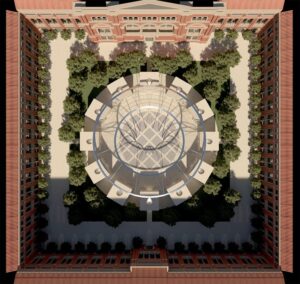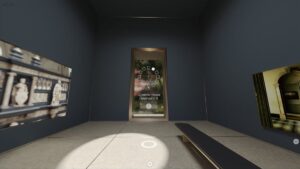Case study analysis – Perfect Spaces: Paintings by Ben Johnson – In partnership with the V&A and London Festival of Architecture
Perfect Spaces: Paintings by Ben Johnson. | The Vault of Contemporary Art (vca.gallery)
The Victoria and Albert Museum along with the National Galleries of Scotland are both institutions that have a long-standing history in the role of culture and historic holdings for both England and Scotland. They are national emblems of the UK’s rich and diverse history and hold objects from around the world that contribute to our education and conversations around equality, diversity, and inclusivity within how we consume our cultures and histories in the present day.




 The exhibition Perfect Spaces: Paintings by Ben Johnson was held in virtual space in collaboration with the V&A museum and Make architects to showcase the works of Ben Johnson alongside the London Festival of Architecture. The online exhibition took place from the dates of 16th June 2021 – 30th October 2021. Ben Johnsons paintings of architecture are displayed in a series of 12 pavilions that are placed in a circle in the John Madejski Garden at the V&A. The exhibition was a celebration of the relationships between architecture and iconic buildings in our cultural landscape but also intertwined the relationship with the digital and the future of exhibition making, allowing for a whole diverse group of people to explore the works of art but also enjoy the virtual space of the V&A from the comfort of their homes. To me this exhibition is a prime example of an educational resource which is easy to navigate and invites audiences to engage with works that they wouldn’t necessarily have been interacted with before.
The exhibition Perfect Spaces: Paintings by Ben Johnson was held in virtual space in collaboration with the V&A museum and Make architects to showcase the works of Ben Johnson alongside the London Festival of Architecture. The online exhibition took place from the dates of 16th June 2021 – 30th October 2021. Ben Johnsons paintings of architecture are displayed in a series of 12 pavilions that are placed in a circle in the John Madejski Garden at the V&A. The exhibition was a celebration of the relationships between architecture and iconic buildings in our cultural landscape but also intertwined the relationship with the digital and the future of exhibition making, allowing for a whole diverse group of people to explore the works of art but also enjoy the virtual space of the V&A from the comfort of their homes. To me this exhibition is a prime example of an educational resource which is easy to navigate and invites audiences to engage with works that they wouldn’t necessarily have been interacted with before.
Going through the exhibition you can click through into different rooms from a central base, go into different themed rooms that have works of art and descriptions with audio voice overs and videos. You can click on images and zoom in on works looking at the intricate detail on the high-quality images that have been uploaded, getting a closer and more personal interaction with the works.
Part of the exhibition also invites you to walk through the space of the artists himself. Taking a unique experience into the origins of where the works originally were created. This is of most interest to people and tells a deeper story of the history of the artworks and their connections and meanings not only to the exhibition but also to artists, audience, and the spaces within themselves.
The virtual experience and collaboration with the V&A and Make Architects also helps to redefine and visualise a new space for art and architecture. The institution of the V&A with its buildings which have stood historically for so many years can literally be transformed in one virtual space and are invited into the homes of its audiences, expanding our vision of what a historic sight can be and mixing this with the contemporary. It is an exciting invention that can invite a new way in which we interact with gallery/museum spaces and one that can inspire to bridge that gap between the online and in person exhibitions, opening culture and the arts to a wider and broader target audience.
For our project we have been tasked by the National Galleries of Scotland to tackle the problem of a broader more blended demand for content online: especially following the response from the GLAM sector (Galleries/Libraries/Archives and Museums) during the pandemic. Bridging the gap between in person and online experiences.
Our collaboration with NGS tasked us to open the exhibition achieve and make it into a living resource whilst building on the digital pivot to find a new way to engage our target audience of 16–24-year-olds.
During the pandemic the GLAM sector realised that it was prevalent that they move further into the digital. Not only to engage audiences whilst their doors were shut to the public but also to create further diversity within the way people collectively engaged with the works. The NGS website although designed to be easily accessible, didn’t have the amount of information readily available for the public to be able to gain insight into the works and behind the scenes content that many other major galleries and museums were providing during the height of the pandemic.
The idea of an interactive space opens up a plethora of possibilities for the GLAM sector. It invites the underrepresented communities to be able to share in the wide spread knowledge of art and culture. In the book ‘Future of Creative work’ Rui Oliveira Lopes states ‘Digital technologies are commonly pointed to as media designed to offer an interactive educational approach to traditional passive content in the museum space and to heighten the learning, visualisation and perception of objects on display. Digital interfaces empower the museum visitor and enable the selection, use and transformation of visual and textual information, particularly in art museums.’[1] Allowing for the museum to bridge that gap between the community and open up the space to be directed by the audience. This is integral to the way that we envision and interact with objects and allows for a more personalised way to learn whilst allowing the audiences to curate and design their own experience within the space without the institutions rigid structures limiting the freedom of though and expression.
I hope that within our project we will be able to expand on this notion of the digital platform and open up the ways in which the exhibition archive can be reimagined through the everyday. As we have seen the V&A alongside Make Architects have successfully opened up a new platform allowing for the public to interact and get to know the intimate works of architects whilst reaching out to large audiences through collaborations with highly recognisable institutions. Their work is not only engaging and exciting but also allows for that personalised/curated vision that you wouldn’t necessarily get in the walls of the institution.
[1] Hearn, Greg. The Future of Creative Work : Creativity and Digital Disruption / Edited by Greg Hearn, Professor, Creative Industries Faculty, Queensland University of Technology, Australia. Northampton: Edward Elgar Publishing, 2020.
Perfect Spaces: paintings by Ben Johnson • V&A Blog (vam.ac.uk)
Perfect Spaces: Paintings by Ben Johnson. | The Vault of Contemporary Art (vca.gallery)
V&A opens virtual ‘vault of contemporary art’ designed by make architects (designboom.com)

